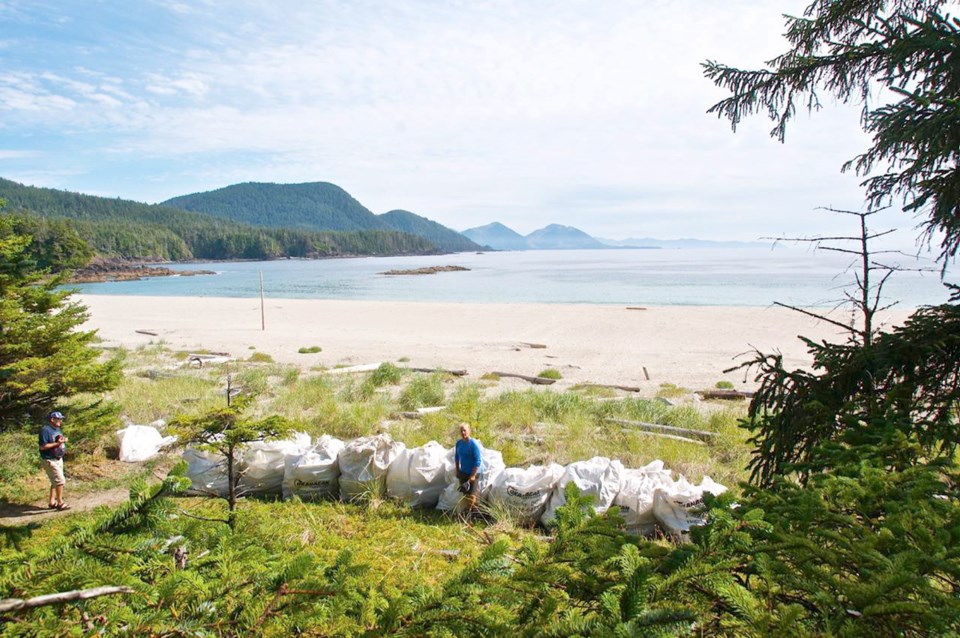Graham McNeil and a friend are kayaking their way around Vancouver Island, bit by bit, year by year.
This July’s leg was supposed to be a highlight: counter-clockwise from Port Hardy around Cape Scott, then up Quatsino Inlet to Coal Harbour.
Except when they pulled into Experiment Bight — a long-awaited destination — on Day 2, they found themselves surrounded by piles of plastic garbage: shrimp traps, shampoo containers, Styrofoam from smashed-up boats, drift-net floats the size of hotdog buns …
So they paddled around the cape to Guise Bay. More debris.
It didn’t get better after that.
“We hiked to the lighthouse the next day and explored a pocket beach out along the point,” McNeil said. “It was littered with crap, enough to really detract from the remoteness of the location.”
After that they paddled down to Grant Bay. “That beach was probably the worst we had seen.” Fishing floats, plastic cartons, lengths of rope embedded in the sand. …
Which is why, two weeks ago, McNeil and his son Brent made the long drive back from the Lower Mainland to the north Island with the express purpose of picking up the garbage.
That’s right, they took it upon themselves to hike into Grant Bay and spend a day and a half filling 14 giant feed bags with well over a tonne of shoreline trash.
They have no official standing. McNeil is a 56-year-old employee of Nav Canada, the air traffic control outfit. His son is a University of B.C. engineering student. They just love the outdoors, hate what’s happening to it.
“It drives me crazy when I go up there,” McNeil says. “It’s fairly disheartening. You think you’re in a pristine, isolated wilderness.”
He’s not the only one picking up the garbage. He ran into a Western Forest Products crew doing the same thing.
The Living Oceans marine-conservation group just completed two forays — 18 volunteers each time — into north Island areas so remote that it took a helicopter to sling out close to three tonnes of flotsam and jetsam.
A similar effort last year found debris — floats, nets, totes, polypropylene rope — from all over the Pacific Rim. “This year it was overwhelmingly Japanese,” said the group’s executive director, Karen Wristen.
In 2013, Japan gave Canada $1 million to clean up debris from the 2011 tsunami. Canada handed the money to the B.C. government, which has so far passed out $663,738 (the Environment Ministry expects the rest to be allocated this year) to six groups to help their shoreline-clearing efforts. That included $270,000 to the Vancouver Aquarium, which in turn doled out funds to non-profits including Living Oceans to aid their on-the-ground efforts.
The money only goes so far. Wristen’s group — find it at livingoceans.org — is raising funds to pay for more helicopter time.
There’s also the simple matter of access and horsepower. While efforts like the Great Canadian Shoreline Cleanup — a 20-year-old collaboration between government and non-profits — regularly turn out volunteers relatively close to urban areas, it’s harder to round up people to scour the remote, sparsely populated parts of the coast.
This isn’t just a question of cosmetics, of tidying up for prettier postcards. It’s important to remove the big pieces of garbage before the surf pounds them into tiny plastic particles that get ground into the sand, impossible to remove, McNeil says.
That’s backed up by a Living Oceans study that found a disturbing amount of microscopic particles in the food chain. The study cited estimates that 60 to 90 per cent of marine debris is plastic. Other research found 90 per cent of seabirds have plastic in their guts. This is a pre-tsunami problem. Gear — ropes, nets, traps — that used to be made from materials that broke down relatively quickly is now made from durable plastic.
“If we could somehow change back to natural materials, that would greatly benefit the ocean,” Wristen says. Might be wishful thinking, though.
Meanwhile, McNeil, who chose Grant Bay because of its relatively easy access, has headed back to the Lower Mainland frustrated by what he left behind up-Island.
“We were only getting the low-hanging fruit.”
And no, he says, you can’t just blame it on the tsunami. Much of what he found had no connection with that disaster.
“It’s such a sad reflection on what we’re doing.”



